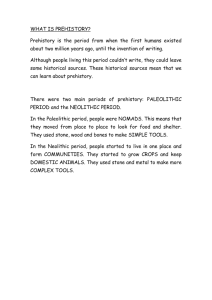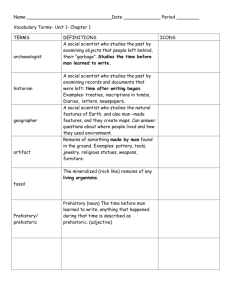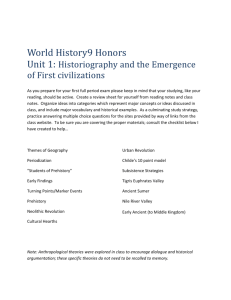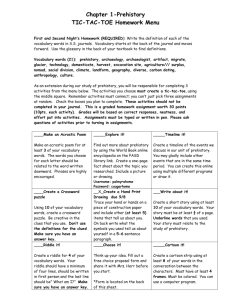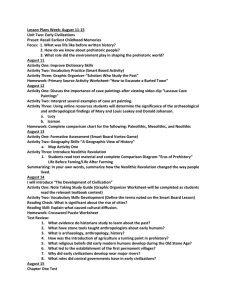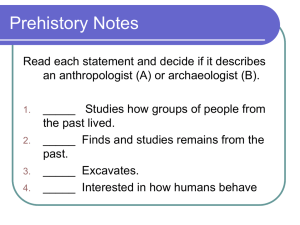Unit Plan
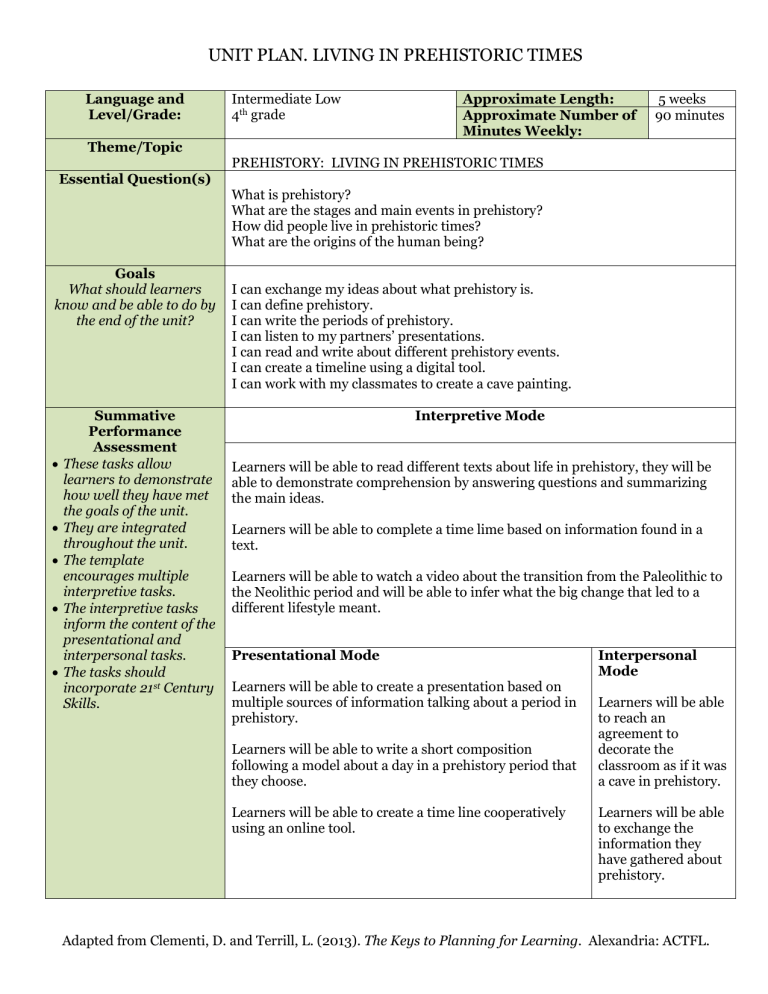
UNIT PLAN. LIVING IN PREHISTORIC TIMES
Language and
Level/Grade:
Theme/Topic
Intermediate Low
4 th grade
Approximate Length:
Approximate Number of
Minutes Weekly:
PREHISTORY: LIVING IN PREHISTORIC TIMES
5 weeks
90 minutes
Essential Question(s)
What is prehistory?
What are the stages and main events in prehistory?
How did people live in prehistoric times?
What are the origins of the human being?
Goals
What should learners know and be able to do by the end of the unit?
I can exchange my ideas about what prehistory is.
I can define prehistory.
I can write the periods of prehistory.
I can listen to my partners’ presentations.
I can read and write about different prehistory events.
I can create a timeline using a digital tool.
I can work with my classmates to create a cave painting.
Interpretive Mode Summative
Performance
Assessment
These tasks allow learners to demonstrate how well they have met
the goals of the unit.
They are integrated
throughout the unit.
The template encourages multiple
interpretive tasks.
The interpretive tasks inform the content of the presentational and
interpersonal tasks.
The tasks should incorporate 21 st Century
Skills.
Learners will be able to read different texts about life in prehistory, they will be able to demonstrate comprehension by answering questions and summarizing the main ideas.
Learners will be able to complete a time lime based on information found in a text.
Learners will be able to watch a video about the transition from the Paleolithic to the Neolithic period and will be able to infer what the big change that led to a different lifestyle meant.
Presentational Mode
Learners will be able to create a presentation based on multiple sources of information talking about a period in prehistory.
Learners will be able to write a short composition following a model about a day in a prehistory period that they choose.
Learners will be able to create a time line cooperatively using an online tool.
Interpersonal
Mode
Learners will be able to reach an agreement to decorate the classroom as if it was a cave in prehistory.
Learners will be able to exchange the information they have gathered about prehistory.
Adapted from Clementi, D. and Terrill, L. (2013). The Keys to Planning for Learning. Alexandria: ACTFL.
UNIT PLAN. LIVING IN PREHISTORIC TIMES
Learners will be able to provide and receive feedback to / from their classmates about their presentations.
Cultures
(Sample Evidence)
Indicate the relationship between the product, practice, and perspective.
Product: Prehistory timeline
Practice: Working with my mates on readwritethink.org
Perspective: Appreciating new technologies as a 21 st century tool.
Product: Cave painting
Practice: Exchanging ideas about art.
Perspective: Art has changed because materials and human vision have evolved.
Product: Power point presentation
Practice: Inferring the most important facts in a period of prehistory
Perspective: Valuing the discoveries and/or inventions in a particular period of prehistory.
Connections
(Sample Evidence)
Making Connections
Learners build, reinforce and expand their knowledge of history while using the language to develop critical thinking and to solve problems creatively.
Language Comparisons
Acquiring
Information and
Diverse
Perspectives
Learners access and evaluate information about the human origins and value evolution and advances along time.
Comparisons
(Sample Evidence)
Learners realize the similarities between Spanish and
English language (paleolítico-paleolithic/ neolíticoneolithic/ metal ages- edad de los metales)
Toolbox
Language Functions Related Structures/Patterns
Describing a day in prehistory Past Simple Tense
Cultural
Comparisons
Learners compare
Stone Age in Spain and the UK.
Vocabulary
Expansion
Tier 1
Presenting information about a period in prehistory
Time markers.
Complex sentences
Paleolithic,
Neolithic, cave, tools, period, age,
Adapted from Clementi, D. and Terrill, L. (2013). The Keys to Planning for Learning. Alexandria: ACTFL.
UNIT PLAN. LIVING IN PREHISTORIC TIMES nomads, sedentary, archeologist, discovery, invention, agriculture, huts, gather, fire, stone, pottery, wheel…
At that time, first, later, ago, before, after…
Tier 2
Think, suppose, believe, guess…
Why? Because
Hypothesizing about how people lived in prehistory
Justifying
Expressions of opinions. Guessing
Questions (Why?)
Answers (Because)
Key Learning Activities/Formative Assessments
Key Learning Activity/Formative
Assessment
(representative samples from beginning to end of unit)
How does this activity support the unit goals or performance tasks?
Watch a documentary about the origins of human beings
Gather information to complete the first and second columns in a KWL chart
Decorate the classroom as if it was a prehistory cave
Receive information about the appearance of humans on Earth
Answer the essential questions: what do I know about prehistory and what do I want to know?
Reach an agreement about how to do it according to what we have learnt.
Mode of
Communicati on
Interpretive
Interc ultura lity
Self
Comm unity
World
S
Presentational
Interpersonal
S, C
Prepare a presentation about a period in prehistory using power point and in small groups
Create a time line using an online tool
Present information about a period in prehistory and give and receive feedback
Organize chronologically events in prehistory using ICT
Change Resources
Timelines
http://timerime.com/es/
http://www.dipity.com/
http://www.readwritethink.org/files/resources/interactives/timeline_2/
Students’ research.
http://catedu.es/chuegos/historia/historia.swf
Presentational
Interpersonal
Interpretive
Presentational
Interpersonal
Interpretive
Presentational
Interpersonal
Interpretive
Technology
Integration
S, C
S,C
S, C, W
Students can use the
Internet as a source of information and tool for learning and share their knowledge and learning experiences in the
English blog.
Adapted from Clementi, D. and Terrill, L. (2013). The Keys to Planning for Learning. Alexandria: ACTFL.
UNIT PLAN. LIVING IN PREHISTORIC TIMES
http://www.juntadeandalucia.es/averroes/html/adjuntos/2007/09/13/0030/prehist oria/entrada/entrada.htm
http://213.0.8.18/portal/Educantabria/ContenidosEducativosDigitales/Primaria/Con o_3_ciclo/CONTENIDOS/HISTORIA/DEFINITIVO%20PREHISTORIA/misitio6/index.
htm
http://science.nationalgeographic.com/science/prehistoric-world/prehistoric-timeline/
http://www.bbc.co.uk/sn/prehistoric_life/human/species/
http://www.bbc.co.uk/sn/prehistoric_life/human/species/
http://www.primaria.librosvivos.net/archivosCMS/3/3/16/usuarios/103294/9/5EP_
Cono_in_ud13_prehistory_1/frame_prim.swf
Virtual visit to a cave painting
Videos: http://cuevas.culturadecantabria.com/
http://www.youtube.com/watch?v=qOFB3JfYq5c (Spanish)
http://www.youtube.com/watch?v=MYbDJF_gMtw ( English)
http://www.bbc.co.uk/history/handsonhistory/ancient-britain.shtml
(motivational video for the writing activity)
Adapted from Clementi, D. and Terrill, L. (2013). The Keys to Planning for Learning. Alexandria: ACTFL.
